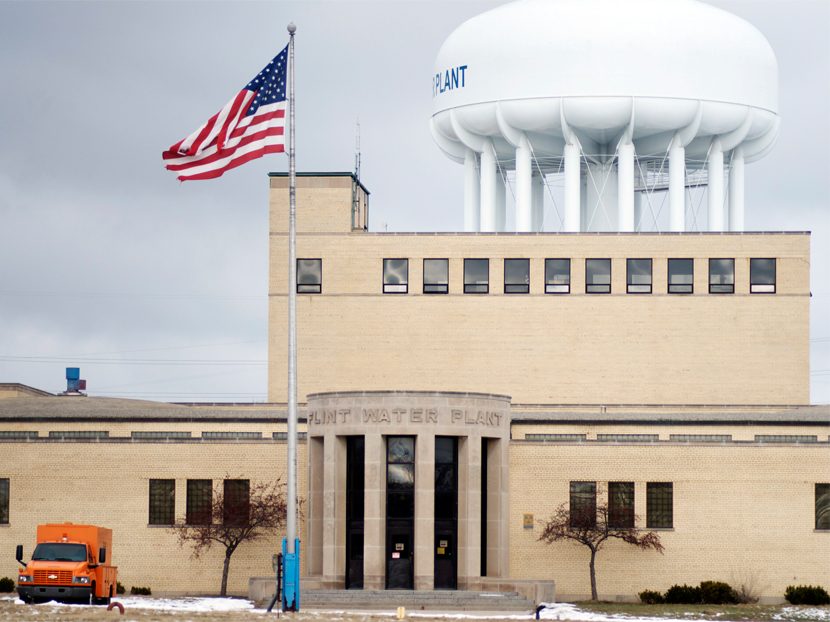Is America’s Drinking Water Safe?
Aging infrastructure is putting our drinking water at risk.

There are two good reasons readers should be asking if our drinking water is safe. The obvious one is the responsibility we share to create healthy communities for our families and ourselves. The other reason is that some aspects of our drinking water problem represent enormous undertakings, offering significant business opportunities for plumbing professionals.
Lead Infrastructure
Sometimes it seems as if the mainstream media is looking for ways to alarm the public and boost their audience ratings, but lead in the bloodstreams of our children remains a genuine problem. It is likely caused to a significant degree by lead service lines installed in the first half of the 1900s and perhaps lead soldering, which wasn’t banned until 1986.
We drink about 1 billion glasses of water per year from 152,000 public water systems. The Centers for Disease Control and Prevention says lead poisoning can damage the central nervous system, kidneys and reproductive system. At high levels, especially in children, it can cause coma, convulsions and death.
The Natural Resources Defense Council notes that about 6 million lead service lines are in the ground across the country needing replacement. And Rachel Layne of CBS News wrote last November that reports from the American Water Works Association (AWWA) suggest, “[piping is] being replaced at an average rate of 0.5 percent a year — at that pace, it would take roughly two centuries to renew the whole system.”
Meanwhile, AWWA’s Paul Olson believes there has been some improvement in the situation in the past 15 years, especially in the past few years since 12 or more deaths in Flint, Mich., thrust drinking water into the national media spotlight. Around the time of the Flint tragedy, a University of California study found that at least 21 million Americans were getting water from systems violating EPA health standards.
“Restoring the existing system will cost another $1 trillion and take about 25 years,” Olson explains. “We do surveys every year showing that we certainly have not solved the problem. But despite growing cities, our new infrastructure needs have been marginally reduced, rather than getting worse. We’re trying. Nobody likes lead.”
Olson describes the numerous economic, political and technical challenges faced by cities as they accept the reality of aging lead and other infrastructure.
Trenchless Line Replacement
One bright spot is the success of relatively new trenchless line repair and replacement technologies. Some of these have been applied to lead service line replacements in the Michigan cities of Flint and Lansing, as well as Chicago and other cities across the country.
Trenchless means you don’t have to dig up the whole existing line, Olson explains, which provides some relief for the difficult municipal/homeowner cost problem. It also reduces the number of homeowners resisting what could be a life-saving upgrade.
There are two categories of trenchless remedies: linings for existing pipe and pipe bursting or splitting. Linings can come in the form of plastic tubes, sprays or felt plus resin, which cures after it is inserted. In all these cases, the lining is pulled into an existing pipe, sealing off the water from contact with the old pipe exterior.
Pipe bursting or splitting are used to completely replace a line along the path of an old pipe, again with minimal digging. The new pipe or tube is fitted with a bursting head, shaped almost like a bullet. It June also have fins to help break the old pipe as it moves through the line. The tip of the bursting head is narrow enough to fit inside the existing pipe, and then it widens to a few inches larger than the new pipe.
The bursting head and the new pipe are pulled through the host pipe using a chain and winch, fragmenting the old pipe and creating a cavity for the new pipe. If necessary, the new pipe can be a bit larger than the pipe it is replacing. For some of the harder materials, a cutting head is needed and the pipe is split rather than fragmented. In many of these operations, small CCTV cameras are used to guide new tubes or liners into position.
Challenges in Flint
“We’ve done thousands of replacements in Flint,” says Joe Parks from Flint-based Goyette Mechanical. “We had between four and six crews going in 2017 and 2018.”
Parks says one of the biggest problems was the scale of the project and scheduling the work with homeowners. Technical perils included avoiding existing water mains, fiber optic, cable and other utilities.
“We’re penetrating the basement wall in these homes and we have to be careful not to accidentally push the wall in,” Parks notes.
For the contractors doing the installation, key steps to the process, some of which have nothing to do with technical matters, include: Review water-quality test data; Arrange schedule and communicate with homeowners; Communicate parking changes to the neighborhood; Turn off water to affected homes for a few hours; Excavate at each end of the line to be replaced; and Check line to determine the need for replacement.
In addition: Complete the replacement as per AWWA standards (www.awwa.org/resources-tools/resources/lead) and test; Restore water service, flush system using an outside faucet or ask homeowner to flush from highest level bath or sink faucet; Restore landscaping, sidewalks and paving; and Provide homeowner recommendations on periodic flushing/aerator cleaning in the weeks following the replacement.
In many cities, the municipality only replaces from the water main to the property line, with the remainder of the service being the homeowner’s responsibility. In some cases, the same contractor June do the work but the homeowner bears the cost. Some municipalities provide a contractor list to guide homeowners.
Partial pipe replacements, not including the homeowner portion, are not recommended. But, many cities are doing them anyway because the cost for the whole job is prohibitive, homeowners are resistant and bylaws June not support complete replacement without homeowner agreement.
Municipal Folly
“Published studies and an EPA advisory make it very clear that there isn’t much sense in a municipality doing only a partial replacement,” says Erik Olson of the Natural Resources Defense Council. “It just shakes all the lead particles loose and makes the problem worse … Some cities like Chicago are not getting the message and continue doing partial replacements. Washington, D.C., was doing partials and realized it was a big problem. Now there is a rule for one federal-funding tranche that cities doing partials don’t qualify for the support.”
Olson congratulates Lansing, Mich., for replacing all its lines quickly.
“Lansing did it in less than 10 years, other cities have finished in 5 years, Flint will likely be done after 3 years,” Olson notes. “So it can and should be done quickly.” Pittsburg has reportedly set aside $40 million to replace all its 15,000 service lines, but many municipalities have not.
Cities sometimes create their water problems themselves when trying to save money or improve the system, he explains. Flint famously tried to save municipal funds by switching its water source. Newark tried to reduce disinfectant to improve its water quality and inadvertently created corrosion.
“Most of the problems are caused by aging infrastructure that municipalities don’t replace on time,” Olson explains. “There are a quarter million water main breaks every year in this country. A large number of water treatment plants can’t even remove pesticides and modern industrial chemicals. These problems need to be addressed. We have the technology we need. They could use activated carbon or a membrane system and solve this. Cincinnati put in activated carbon 20 years ago and eliminated its industrial chemical problem.”
Although his organization sues bigger cities if they ignore its advice, Olson has sympathy for smaller towns.
“It’s a significant investment; $3,000 to $5,000 per house,” Olson says. “Small communities can’t afford to comply. We have 52,000 communities like that. If you add the private wells, it’s more like 100,000. Some can’t even afford regular testing and they’ve been out of compliance for years. In some cases, we should be able to solve it by consolidating the challenges and applying resources. But it’s not easy.”
Climate Change
It’s almost impossible to talk about cities and infrastructure without considering climate change risks, trends and events. From drought and horrific fires in California, to Alaska and Canada warming four times more quickly than the rest of the world, to intense storms or unusual melting dumping several feet of water on the Midwest, North Carolina, Florida and Texas — it’s clear that 100 years of aging is not the only threat to water infrastructure.
After the fires in Paradise, Calif., which killed 85 people and obliterated 14,000 homes, it was discovered that as residences and their contents burned, the water system became contaminated by a cancer-causing chemical called benzene.
In addition to quickly overwhelming and damaging sewage and drinking water systems, floods present other dangers. After the floods in North Carolina, animal carcasses and manure were spread far and wide and began to rot. If water containing dead animals remains for very long in a flood zone, uncontrolled bacteria beings to grow and spread in the water.
The World Health Organization notes that floods lead to an increase in the transmission of typhoid fever, cholera, leptospirosis and hepatitis, malaria, dengue, dengue hemorrhagic fever, yellow fever and West Nile Fever.
A collaborative study by scientists in Bristol, Minneapolis and Washington reports that approximately 41 million U.S. residents are at risk from flooding and the risk is increasing each year.
Despite all this potential for trouble, there is some good news. The answer to the question, “Is America’s drinking water safe?” would be, on average and in relative terms, “Yes.”
Managed by Yale University and Columbia University in collaboration with the World Economic Forum, the Environmental Performance Index ranks about 180 countries according to drinking water safety. The United States ranks tenth and Canada ranks eighth.
Nonetheless, we have an infrastructure problem and for plumbing professionals, it June also be an opportunity.





